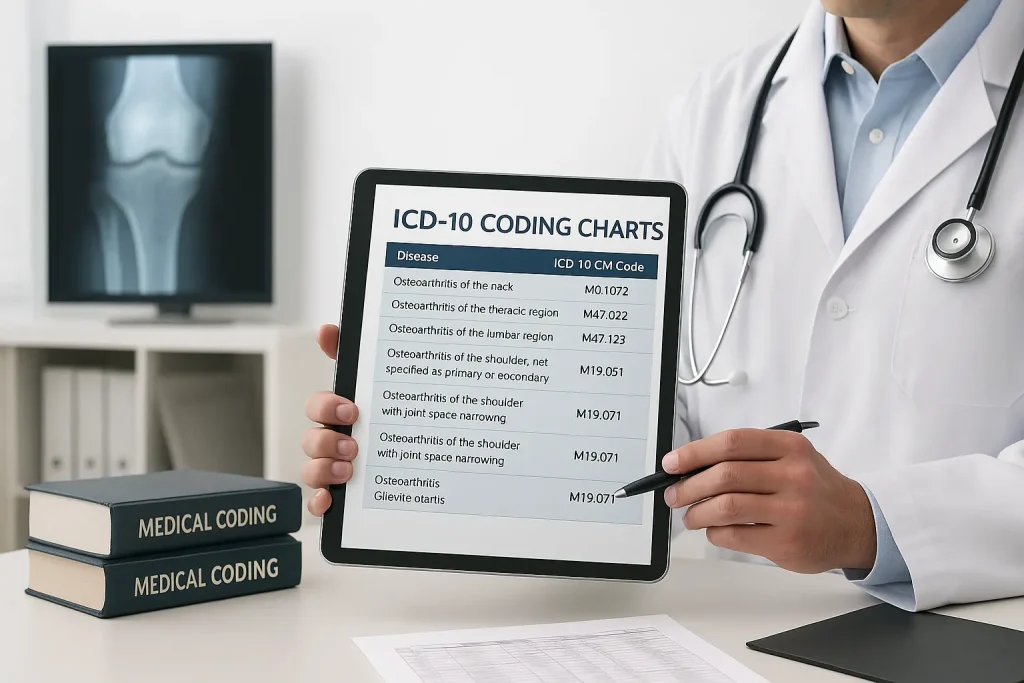Introduction: The Specificity Problem in Osteoarthritis ICD-10 Coding
For medical coders, billers, and healthcare providers, accurately assigning the correct osteoarthritis ICD-10 code is more than a clerical task—it is a critical determinant of compliance, reimbursement, and clinical accuracy. The coding range for Osteoarthritis, found under categories M15–M19 within Chapter 13 of the ICD-10-CM, is one of the most frequently utilized and yet most frequently miscoded ranges in the Musculoskeletal System chapter.
The search for the correct code often leads users to the general code, M19.90, for Unspecified osteoarthritis, unspecified site. While M19.90 is a billable code for the 2026 edition (effective October 1, 2025) , relying on “unspecified” codes carries an inherent risk of payment scrutiny, particularly for high-value procedures like joint replacements. Maximum specificity is not just preferred; it is mandated for appropriate clinical representation and reimbursement in complex cases.
This guide cuts through the ambiguity. We integrate the latest FY 2025 ICD-10-CM Official Guidelines (effective October 1, 2024) and future FY 2026 updates to provide a definitive, compliance-focused blueprint. We will move beyond simple code definitions to provide the clinical documentation key needed to select the highest-specificity code, ensuring your claims are accurate and defensible.
The Core ICD-10 Framework for Osteoarthritis (M15–M19)
The coding structure for Osteoarthritis is organized by site and etiology (cause) within the ICD-10-CM code set. Understanding this hierarchy is the first step toward achieving professional-grade specificity. The M15–M19 range (Osteoarthritis) is found under the larger category M00–M99 (Diseases of the Musculoskeletal System and Connective Tissue).
The framework is structured into the following key ranges, which should serve as your primary navigational index:
M15
Generalized osteoarthritis (multiple joints)
M16
Osteoarthritis of the hip
M17
Osteoarthritis of the knee
M19
Other and unspecified osteoarthritis
The Three-Step Decision Path
To correctly code any osteoarthritis diagnosis, coders must follow a three-step decision path:
(Primary, Secondary, or Post-Traumatic)
The Unspecified Code Alert: When M19.90 Becomes a Risk
The code M19.90 (Unspecified osteoarthritis, unspecified site) is the general entry point for many searches. While it is a billable classification, its use signals incomplete documentation or a lack of specific diagnostic information.
Professional guidance strongly advises coders to use site-specific and laterality-specific codes (M16.x or M17.x) whenever possible, especially when evaluating patients for high-value treatments. The use of M19.90 should be reserved only for scenarios where the documentation is legitimately ambiguous or the site does not require surgical evaluation.
| ICD-10 Code | Description | Primary Use Case / Caution |
|---|---|---|
| M19.90 | Unspecified osteoarthritis, unspecified site | Should be avoided. Used when documentation is incomplete. Low-value reimbursement risk. |
| M19.91 | Primary osteoarthritis, unspecified site | Should be used only if site specificity is absent, but etiology (primary OA) is confirmed. |
| M19.92 | Post-traumatic osteoarthritis, unspecified site | Used when the cause is known to be post-traumatic, but the specific joint is not documented. |
High-Specificity Coding: Knee (M17.x) and Hip (M16.x)
Osteoarthritis of the knee (M17.x) and hip (M16.x) are associated with the highest volume of advanced medical interventions, making specificity mandatory for demonstrating medical necessity and securing appropriate payment.
The M16 and M17 code sets allow for granular detail, distinguishing between:
- Laterality: Right, Left, or Bilateral (Bilateral Hip: M16.0; Right Knee: M17.11).
- Etiology: Primary (due to wear/tear), Secondary (due to another underlying condition), or Post-Traumatic (due to prior injury).
Required Documentation Key for Primary OA (M17.11 and M16.0)
To move beyond the default unspecified codes, coders must confirm the Key Documentation elements provided by the physician. This is the critical step often missing from standard code references.
| Specific ICD-10 Code | Description | Key Documentation Required |
|---|---|---|
| M17.11 | Unilateral primary osteoarthritis, right knee |
|
| M16.0 | Bilateral primary osteoarthritis of hip |
|
For a claim involving a total knee arthroplasty (TKA), selecting a code like M17.11 (Primary OA, Right Knee) substantiated by these documentation points is far more robust than using M17.9 (Unspecified OA of Knee).
Addressing Complex Sites: Ankle, Foot, and Shoulder
Specificity is not limited to the knee and hip. The ICD-10-CM provides detailed codes for other common sites, such as the ankle/foot and shoulder:
M19.271
Secondary osteoarthritis, right ankle and foot.
M19.011
Primary osteoarthritis, right shoulder.
Ensure the provider documentation confirms both the anatomical site and the specific etiology (e.g., secondary OA due to a prior injury or condition) to utilize these detailed codes.
Mandatory FY 2025 Compliance: The Latest CMS Guidelines
Compliance is based on the Fiscal Year (FY) updates published by the Centers for Medicare & Medicaid Services (CMS) and the National Center for Health Statistics (NCHS). The FY 2025 ICD-10-CM Official Guidelines for Coding and Reporting (effective October 1, 2024) contain critical updates for the Musculoskeletal System (Chapter 13) that must be immediately implemented.
Rule 1: Bone versus Joint Coding Distinction
A common error occurs when coders confuse bone pathology with joint pathology. CMS guidelines clarify that for certain conditions, even if the bone is affected near the joint (such as avascular necrosis or osteoporosis), the site designation in the code must reference the bone, not the joint.
- Osteoarthritis (M15–M19): Code to the joint site (e.g., M17.x for the knee).
- Osteoporosis (M80, M81): Code to the bone site if fracture is present (M80.x), or simply M81.x if no current fracture is present.
This rule is vital when coding for an elderly patient who may have both hip osteoarthritis (M16.x) and generalized osteoporosis (M81.x).
Rule 2: Multiple Sites vs. Multiple Codes (The M15 Dilemma)
The FY 2025 guidelines reinforce the decision point between using a “multiple sites” code and reporting separate codes for each joint.
- For conditions like osteoarthritis, a “multiple sites” code is available (Category M15, Generalized osteoarthritis).
- For other musculoskeletal conditions where a single “multiple sites” code is not provided, multiple codes must be used to indicate all different sites involved.
The “Payer Dilemma” (as outlined in the research) means that while M15.9 (Generalized OA, unspecified) may capture the overall disease burden, if the current encounter focuses on a single joint for high-value treatment (e.g., knee injection), the site-specific M17.x code should be prioritized. We recommend verifying local payer policies while always advocating for the highest-specificity site code (M16.x, M17.x) when treatment focuses on one area.
The Z-Code Requirement: Sequencing History and Risk
Proper code sequencing and the strategic use of Z-codes are mandatory for fully capturing the patient’s clinical complexity. Z-codes (Z80–Z87) are utilized as secondary codes when a historical condition or family history affects the current care or influences treatment decisions.
A common sequencing requirement for osteoarthritis patients involves using Z87.310 (Personal history of (healed) osteoporosis fracture).
Sequencing Example: OA of the Hip with History of Fracture
If a patient presents with severe primary osteoarthritis of the hip (M16.9) and has a known history of a healed osteoporosis fracture, the use of Z87.310 as a secondary diagnosis is essential.
Correct Code Sequence:
- M16.9 (Osteoarthritis of hip, unspecified)
- M81.0 (Age-related osteoporosis without current pathological fracture)
- Z87.310 (Personal history of (healed) osteoporosis fracture)
This detailed sequencing informs the payer about the patient’s elevated risk profile and helps justify the treatment complexity, demonstrating superior documentation compared to simply reporting M16.9.
Managing Exclusions: M15 (Polyarthritis) and M47 (Spinal Arthrosis)
To be a true authority resource, you must clearly define what the M15–M19 codes are not. Exclusion notes prevent common coding errors and misclassification.
The M19 code range (Other and unspecified osteoarthritis) carries specific exclusion notes:
Excludes1
Polyarthritis (M15.-): This is a rigid exclusion. An Excludes1 note means that the two conditions should generally not be coded together. Osteoarthritis is degenerative, whereas polyarthritis is inflammatory.
Excludes2
Arthrosis of spine (M47.-) and Osteoarthritis of spine (M47.-): An Excludes2 note means that while the excluded condition is not part of the code being discussed, a patient may have both conditions concurrently, and both codes should be used if documented.
For example, a patient can have bilateral knee osteoarthritis (M17.9) and concurrently have arthrosis of the spine (M47.x). Both conditions should be reported.
Frequently Asked Questions (FAQ)
What is the current M19.90 effective date?
M19.90, Unspecified osteoarthritis, unspecified site, is effective for the 2026 edition, starting October 1, 2025.
How do I code chronic vs. acute musculoskeletal conditions?
Chronic or recurrent conditions, including post-traumatic osteoarthritis (M19.92), are found in Chapter 13. Current, acute traumatic injuries are coded to Chapter 19 (Injury codes). If unsure, query the provider for clarification.
When must I use a specific joint code (M16 or M17)?
Use a specific joint code when you need to substantiate medical necessity for a site-specific, high-value procedure, such as a joint replacement or a steroid injection.
Does the FY 2025 update add new OA codes?
The FY 2025 guidelines update the official narrative rules (e.g., the Bone vs. Joint rule) and reference new codes in related categories like synovitis and tenosynovitis (M65.97x).
Conclusion: Achieving Coding Mastery
Achieving mastery in coding for osteoarthritis ICD-10 codes means moving beyond the simple M19.90 dictionary definition and embracing specificity, compliance, and clinical utility. By structuring your documentation and coding based on the three pillars identified in this guide, you will ensure superior coding accuracy:
Prioritize Specificity
Immediately funnel all general searches toward the high-value anatomical codes (M16.x and M17.x) and utilize the Etiology classification (Primary, Secondary, Post-Traumatic).
Ensure Compliance
Rigorously integrate the CMS FY 2025/2026 Official Guidelines, including the “Bone versus Joint” rule and “Multiple Sites” guidance.
Build Workflow Utility
Use the Required Documentation Key alongside code selection to validate medical necessity and defend against audit risk.
By implementing these strategies, your coding processes will not only comply with regulatory standards but will also accurately reflect the complexity of patient care, securing your clinical and financial standing.
Tools and Further Resources
- Official CMS Guidelines: Refer to the most recent FY 2025 ICD-10-CM Official Guidelines for the full regulatory context.
- AAPC & ICD-10 Data: Use these sites for quick code lookup, but always cross-reference their data with the official CMS guidelines.







